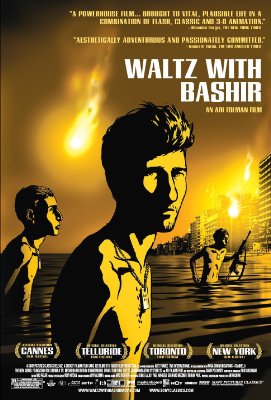Went to see Waltz with Bashir this afternoon at the Prince Charles. Perhaps not the most obvious of choices what with how I’ve been feeling lately but I’d promised myself I’d go and see it as soon as it got to the PCC and I went to see Persepolis the week before (of which more later) so Middle Eastern animation has been rather in my thoughts of late especially with current world events as they are.
The film opens with a friend of the film’s director, Ari Folman, recounting a recurring nightmare of being attacked by 26 dogs and how he can tie this to his experiences serving in the Israeli Defence Force during the Lebanese War of 1982. Though at the time Folman says that he has no memories from that period the meeting triggers a flashback of an incident relating to the Sabra and Shatila massacre. His feelings of guilt and desire to know whether the flashback is a real memory or not lead Folman to interview old comrades and others and to slowly piece together this missing part of his history.
Told in a mixture of formal and informal interviews and scenes from the war it’s extremely powerful and the animation is excellent. Waltz with Bashir isn’t easy to watch but I would strongly suggest that you go and see it. Admirably the film doesn’t shy away from difficult questions and the way that each of Folman’s friends and comrades deals with the events they witnessed or took part in during the war is genuinely moving. That this depth of emotion comes across on screen is a tribute to the animators. No one in the audience moved until at least three quarters of the way through the credits which I also thought was a testament to the strength of the film.

On a lighter note Persepolis is a tragi-comic autobiographical animation about life under two oppressive Iranian regimes and coming of age in exile in Europe.
That may be a bit flippant but this is also a fantastic film – warm, at times hilariously funny and sometimes heartbreaking in the pointlessness of some of the events that it portrays. Marjane Satrapi has brought her graphic novel to life on the screen to wonderful effect. From the elation of the toppling of the Shah’s oppressive regime to the new strictures of the Iranian Revolution via Bruce Lee, metal, punk, Michael Jackson, an education in Austrian exile and much more besides, the amount of history and the eventfulness of Satrapi’s life encompassed by the film is huge.
Whereas Waltz with Bashir‘s style is quite realistic Persepolis looks like a print in motion, befitting it’s origins on the page. It’s also mainly drawn in black and white (with only current events depicted in colour) with a beautiful simplicity and fluidity of line.
Oh and I wish I’d had the opportunity to grow up with her grandmother – hard as nails and witty as hell.
